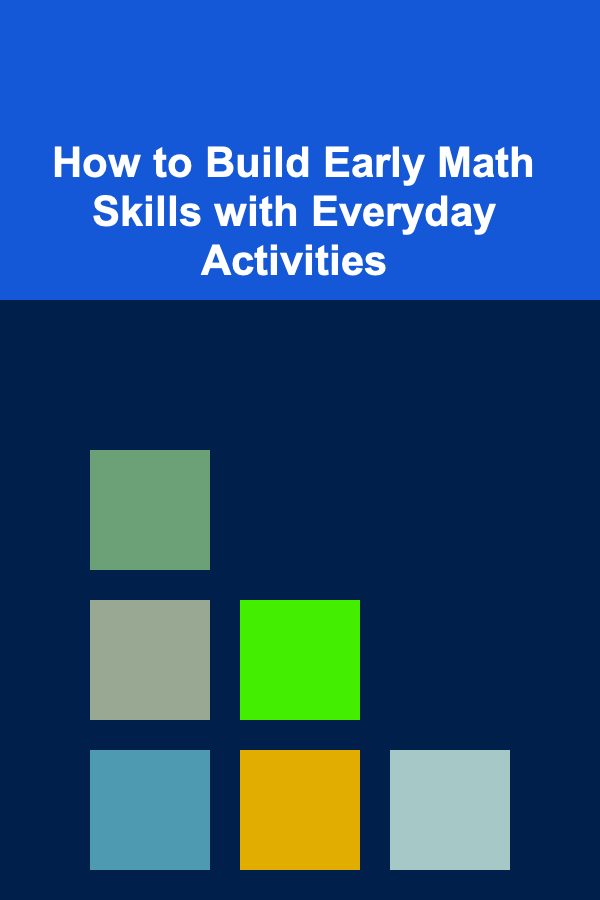
How to Build Early Math Skills with Everyday Activities
ebook include PDF & Audio bundle (Micro Guide)
$12.99$10.99
Limited Time Offer! Order within the next:

Mathematics is often perceived as a complex subject confined to classrooms, but the truth is that it can be integrated seamlessly into everyday life from an early age. By building early math skills through simple, everyday activities, children can develop a strong foundation for later academic success. These early interactions with numbers, shapes, patterns, and measurements help foster a child's curiosity, critical thinking, and problem-solving abilities. Parents and caregivers can play a vital role in this process by making learning fun, engaging, and relevant to the world around them.
In this article, we will explore how to build early math skills with everyday activities, focusing on the ways in which parents and caregivers can incorporate math concepts naturally into daily routines. Through these activities, children will gain a deeper understanding of the world of numbers and shapes, laying the groundwork for future mathematical learning.
Number Recognition and Counting
Counting Objects Around the House
Counting is one of the first and most important math skills that children begin to learn. Even before they fully understand the concept of numbers, young children benefit from counting objects around them. Simple tasks like counting the number of plates on the dinner table, the steps as you walk up or down the stairs, or the number of toys scattered around the room all contribute to early number recognition.
Parents can turn counting into a fun game by asking questions like, "How many apples do we have in the basket?" or "Can you count the number of chairs in the kitchen?" This helps children recognize numbers in the context of their environment and reinforces the idea that numbers represent quantities.
Singing Counting Songs
Songs and rhymes are a fun and effective way to introduce counting to young children. Nursery rhymes like "One, Two, Buckle My Shoe" and "Five Little Ducks" not only help children remember numbers but also encourage them to associate numbers with actions, objects, and familiar experiences. Singing counting songs also reinforces rhythm, which can further enhance mathematical skills like recognizing patterns and sequences.
Use of Everyday Objects for Counting
Children can use everyday objects, such as fruits, buttons, or even socks, to practice counting. This helps them make a concrete connection between the numbers they hear and the quantities they represent. For example, you can place five bananas on the table and say, "Let's count the bananas. One, two, three, four, five." Using tactile objects to count makes the experience more interactive and memorable.
Recognizing Patterns
Sorting and Grouping Objects
Patterns are a fundamental part of math, and they appear everywhere in daily life. Recognizing and creating patterns helps children develop critical thinking skills and an understanding of relationships and structures. One simple activity to build pattern recognition is sorting and grouping objects by size, color, shape, or other attributes.
For instance, you can encourage children to sort their toys by color, such as all the red toys in one group, all the blue toys in another, and so on. Once the items are sorted, ask the child to describe the pattern: "What comes next in the pattern?" This can lead to discussions about repeating patterns and predicting what comes next.
Using Nature to Recognize Patterns
Nature offers an abundance of patterns that children can observe and explore. Whether it's the repeating patterns of leaves on trees, the petals on flowers, or the arrangement of seeds in a fruit, nature provides a rich environment for pattern recognition. Going on a nature walk and asking children to identify patterns in leaves, flowers, and even animal tracks fosters curiosity and helps them see the mathematical relationships in the world around them.
Creating Simple Patterns with Everyday Materials
Building patterns using everyday materials can be a fun and hands-on way to reinforce pattern recognition. Children can create patterns with items such as blocks, beads, or even food items like crackers or slices of fruit. You can start with simple two-item patterns (red, blue, red, blue) and gradually progress to more complex patterns. Encourage children to extend the patterns and create their own sequences.
Introduction to Shapes and Spatial Awareness
Identifying Shapes in the Environment
Shapes are all around us, from the round shape of a ball to the square corners of a table. Helping children identify shapes in their environment is a great way to develop their spatial awareness and geometric understanding. Pointing out the shapes of everyday objects during daily activities, such as during meals, walks, or while playing, helps children learn to recognize common shapes like circles, squares, triangles, and rectangles.
For example, you might ask, "Can you find something that is shaped like a circle?" when looking at a clock, or "What other things can you find that are square, like this box?" As children encounter these shapes in real-world contexts, they begin to understand their properties, like the fact that squares have four equal sides and circles have no corners.
Drawing and Tracing Shapes
Drawing and tracing shapes is another activity that can build a child's understanding of geometry. You can provide children with a variety of drawing materials---crayons, markers, or even chalk---and ask them to draw different shapes. Tracing shapes with their fingers helps children develop fine motor skills while reinforcing their understanding of the form and structure of various shapes.
Creating 3D Shapes with Playdough
Using playdough or clay to make 3D shapes like spheres, cubes, and pyramids can help children understand the difference between two-dimensional shapes and three-dimensional objects. As they roll, pinch, and shape the dough, children can experiment with different forms and learn to recognize the physical properties of solid shapes.
Measurement and Comparing Quantities
Measuring with Everyday Objects
Measurement is an essential math skill that can be introduced early on through activities that involve comparing and measuring quantities. Simple activities, such as using a spoon to measure ingredients for a recipe or comparing the length of two objects, help children develop an intuitive understanding of measurement.
For example, you could ask, "Which is heavier, this apple or this orange?" or "Can you find something in the room that is longer than your pencil?" By using household items to measure weight, length, or volume, children begin to grasp the concepts of comparison and measurement in a hands-on way.
Baking and Cooking Together
Baking is an excellent opportunity to incorporate math concepts such as measurement, fractions, and proportions. When baking cookies or preparing a simple meal, you can involve your child in measuring ingredients, counting the number of teaspoons or cups, and even dividing portions. This not only introduces math in a real-world context but also provides a fun, sensory-rich experience.
Using Comparisons in Everyday Activities
Encouraging children to make comparisons is another effective way to develop their measurement skills. You can ask questions like, "Which cup holds more water?" or "Do you think this toy is bigger than that one?" Such comparisons help children develop their understanding of size, volume, and capacity in an informal and accessible manner.
Problem-Solving and Critical Thinking
Encouraging Logical Thinking with Simple Puzzles
Puzzles are a great way to build critical thinking skills, which are vital for developing mathematical reasoning. Jigsaw puzzles, shape-matching games, and even simple brainteasers can encourage children to think logically and problem-solve. As they work through these activities, they practice spatial reasoning, recognize patterns, and understand relationships between parts and wholes.
Asking "How Many" and "What Comes Next"
Simple questions like "How many cars are in the parking lot?" or "What comes after 5?" encourage children to practice problem-solving and logical thinking. These questions can be used during everyday activities, such as running errands or even on a walk. Asking children to solve small math problems in everyday contexts helps them develop a practical understanding of numbers and mathematical operations.
Engaging in "Math Talk"
Mathematical thinking is not just about numbers; it's also about the language used to describe mathematical concepts. Encourage "math talk" during everyday activities by asking open-ended questions like, "How did you figure that out?" or "Can you explain why that makes sense?" This dialogue helps children develop the ability to reason and articulate their thought processes.
Conclusion
Building early math skills doesn't require expensive materials or formal lessons. By using everyday activities, parents and caregivers can create an environment where math is a natural, enjoyable part of daily life. From counting objects around the house to identifying shapes in nature and exploring measurement with baking, every moment presents an opportunity to reinforce mathematical concepts.
The key to fostering early math skills lies in making learning fun and engaging. By incorporating math into daily routines, children not only develop essential skills but also learn to appreciate the role that math plays in understanding the world around them. As children gain confidence in their mathematical abilities, they are better equipped to succeed in more complex mathematical tasks as they grow older, setting them up for long-term academic success.
Incorporating these simple, everyday activities into a child's life can have a lasting impact on their love for learning and their future relationship with math. So, the next time you tie your shoes, bake a cake, or take a walk, remember that you are not just completing everyday tasks---you are also laying the foundation for a lifetime of mathematical thinking.

Developing a Digital Music Player: An Actionable Guide
Read More
How to Combine Modern and Traditional Lighting Styles in Your Home
Read More
How to Set Financial Goals for Short and Long Term
Read More
How To Explore Quantum Simulation for Chemistry and Materials Science
Read More
How to Plan a Bridal Shower Checklist for the Bride Who Hates Being the Center of Attention
Read More
10 Tips for Staying Ahead of Emerging Cybersecurity Threats
Read MoreOther Products

Developing a Digital Music Player: An Actionable Guide
Read More
How to Combine Modern and Traditional Lighting Styles in Your Home
Read More
How to Set Financial Goals for Short and Long Term
Read More
How To Explore Quantum Simulation for Chemistry and Materials Science
Read More
How to Plan a Bridal Shower Checklist for the Bride Who Hates Being the Center of Attention
Read More